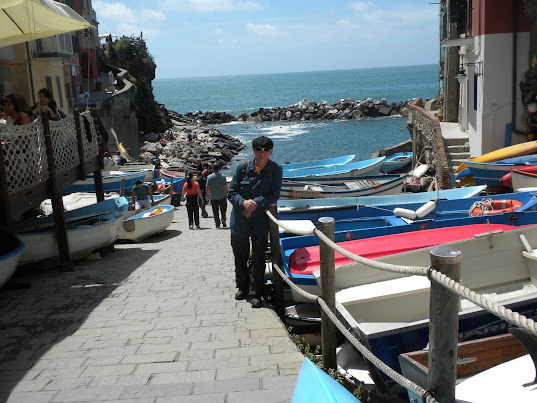Al
writes: After spending the day in the high Alps at Chamonix, it was time
to head south to the sea and sun. We followed Napolean's Route--the route
he took after leaving Elba, landing on the French Riviera, and leading his
newly formed army to its Waterloo. We cut across the southern Alps into
Italy and met the coast at Genoa.
I
have become a bit overconfident in my driving and thought it would be a great
idea to follow the coast road to our destination of Cinque Terre. Not a
good decision. Italy is a bit different for driving than on the German
and French countryside. You have to bring a little more emotion without
hesitation into the driving. Also, the streets get narrower and the
Vespas attack from all directions. I was
already a little nervous after doing a U-turn before a tunnel that would have
shaved off my air conditioner and awning.
Then, the streets got so narrow, I was not sure if I was on a pedestrian-only
alley. My eyeballs were rocking
violently from my Garmin to all mirrors, signs, and pedestrians that did not
hesitate to step in my path. If they
only knew how close they were to being unintentionally ignored by this crazy
American. After over an hour covering
only 15 miles of terror with white knuckles, intense concentration, heart palpitations,
and multiple closed-eyes maneuvers, I said the heck with this and programed my
Garmin to get me to the freeway (autostrada).
Somehow, we made it to our basecamp at lovely Levanto from where we
would explore the Cinque Terre.
The
Cinque Terre is a small portion of the Italian Riviera (about 10 miles) that
has 5 picturesque villages. The entire
area is popular for hiking and biking and just soaking up the local
ambiance. The area is a UNESCO
site. UNESCO sites fall in the
categories of cultural, historical, and natural beauty and are so important to
the world that they make the list to encourage protection for future
generations. I think of the list of
sites as the ultimate bucket list. It is
interesting to look at the list of UNESCO sites in the U.S. The Cinque Terre area was designated an
Italian National Park in 1999, and the first park president, Franco Bonanini,
had great plans to improve the infrastructure for the good of the communities
and the tourists. Unfortunately, he
succumbed to corruption, and greed stopped most of the projects. The lack of an overall preservation and
improvement plan led to disastrous floods on October 25, 2011. The area has almost recovered because of the
hard work of the locals and is still a beautiful, easygoing place to visit.
Our
arrival in Levanto was later than expected, so Carol and I decided to take a
warm-up hike to Bonassola, which is not part of Cinque Terre. The bike/hiking trail follows an old train
route along the coast that is made up of tunnels and openings to see the
ocean. It was a different type of hike
and the views of the coastline were very similar to what you would see in the
Monterey area of California.
For the following two days, Carol and I visited all five of the villages.
RIOMAGGIORE
The
village flows down a ravine to the water's edge. Space is very limited and the boats are
stored in the Main Street on carts to be wheeled down to the very small
harbor. Every sunny day is a laundry
day.MANAROLA
This village was my favorite. It was similar to Riomaggiore, following a ravine to the sea and also along a small peninsula. The buildings seemed to be built on top of each other and I had the impression that if one building was taken away, the whole village would slide into the sea.
CORNIGLIA
Corniglia
is different from the other villages in that it is above the water. In fact, there are 388 steps to reach it from
the train station. At first, we were a
little disappointed in arriving at the nondescript town square. However, in searching for Alberto's Gelato,
we followed a narrow alleyway filled with shops that lead us to the grandest
view of the day.
VERNAZZA
This
village is considered the jewel of the area.
It has the biggest natural harbor (not very big) and is a favorite
stopping place for the many tour boats showing off the Cinque Terre from the sea. The breakwater was an excellent place to rest
and watch the activity.
MONTEROSSO
Monterosso
is the largest of the five villages and is the place to shop. We often took a short hike to a viewpoint
above the various villages, and we were glad we did this in Monterosso. This town had a cemetery at the highest point
above the town in an area that used to be a convent and a castle. The town was also preparing for a religious
procession that evening celebrating the Corpus Domini festival. The locals were in the process of making
elaborate sidewalk art composed of common local materials such as flower
petals, lemon slices, coffee grounds, leaves, popcorn etc. The art work was very creative and unusual.
Our stay in the Cinque Terre was characterized by slowing down and smelling the roses or, in this case, the Margherita pizzas. We had a leisurely lunch every day and strolled the streets and vineyards above the villages. We had a most enjoyable stay on the Italian Riviera.




















You are probably going northwest and not southeast but two places I have been, both by sea, are La Spezia (in the 70's) and Lucca, a picturesque walled city (a few years ago). Both are well worth a visit.
ReplyDeleteYes, we headed to the French Riviera from Cinque Terre. Hated to leave Italy with such a short visit, but the next 2 months in France will be wonderful, I am sure.
ReplyDelete